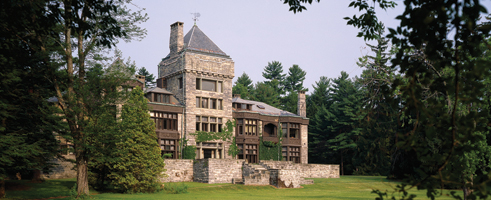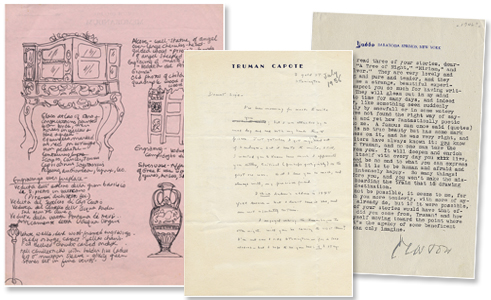The Literary Lights of Artistsí Colony Cast Long Shadows to Smith College

Yaddo Mansion. Photo by Brian Vanden Brink, courtesy the Corporation of Yaddo.
A legendary artists' colony in upstate New York that hosted some of the most illustrious music composers, writers and visual artists of the 20th century—including those with ties to Smith College—is the focus of an upcoming exhibition in the William Alan Neilson Library.
"Unconquered by Flames: The Literary Lights of Yaddo" celebrates the talents and contributions of writers Lola Ridge, Sylvia Plath and Constance Carrier and noted scholar and literary critic Newton Arvin. Their papers are all housed in the Smith College Special Collections and include letters, photographs and original manuscript drafts. Karen Kukil, associate curator of special collections at Smith, is the exhibition's curator.
Yaddo, established in 1900 by financier and philanthropist Spencer Trask
and poet Katrina Trask, is a 400–acre estate in Saratoga Springs, N.Y. Since it officially began
receiving guests in 1926, Yaddo has offered sanctuary and accommodations in the 55–room mansion
as well as roaming rights to the estate's classical gardens and walking trails. Among the more
than 3,500 guests have been composer Aaron Copland and writers John Cheever, Eudora Welty and Truman
Capote. Smith alumna and women's movement pioneer Betty Friedan '42 also arrived for a stay
but reportedly found Yaddo to be too quiet and left after three days.
Most were inspired by the supportive environment and elegant surroundings. American poet Plath '55 wrote many of the poems that were later published in The Colossus, beginning with "The Manor Garden," after staying at Yaddo for more than two months in 1959 with husband British poet Ted Hughes. Her descriptions and drawings of the Yaddo library and its furnishings were meticulously recorded on Smith College memorandum paper and are included in her published journals, which will be on display in the show.
In her journal entry for September 16, 1959, Plath detailed the elegant breakfasts and dinners served in the great dining room. "Honey oozing out of the comb, steaming coffee on the hot–plate. Boiled eggs and butter... sweetbreads, sausages, bacon and mushrooms; ham and mealy orange sweet potatoes; chicken and garden beans."

L to R: Sylvia Plath's journal page describing the Yaddo furnishings on Smith memorandum stationary; letter from Truman Capote to close friend Newton Arvin; letter from Arvin to Capote. Images courtesy Smith College Mortimer Rare Book Room.
Another Smith alumna Constance Carrier '29 was a Yaddo guest in 1975. During her lifetime, she wrote poetry, taught Latin and was a regular contributor to Harper's, Atlantic, The New Yorker, The Nation, Poetry (Chicago) and other periodicals and newspapers.
Lola Ridge, whose papers are part of the Sophia Smith Collection, published five books of poetry, including Firehead, which she wrote during a 15–week residency at Yaddo in 1929. She dedicated the book–length narrative poem, about the Crucifixion, "To Yaddo."
The upcoming Smith exhibition includes a letter that Lola Ridge wrote to husband David Lawson on June 10, 1929, describing her reactions to the luxurious accommodations offered her shortly after her arrival at Yaddo. "I have asked to change my gorgeous room and given it up—private bath and all!" she wrote, "to go another flight up where I shall be more alone and shut in in that room shall not hear a sound."
Unlike Plath, she found the food at Yaddo to be too rich. Again on June 10 she wrote to Lawson. "The German chef—the best of her kind—was appalled at my turning down her gorgeous lunch—she came up to see me about it—I had an awful job explaining & it was as though I had said—'It's no use—I can't stand your poems!'"
Newton Arvin, a Smith professor as well as a major literary critic and biographer, completed his first book, Hawthorne, a biography of Nathaniel Hawthorne, during an initial stay at Yaddo in 1928 while still at the beginning of his career. He eventually became part of an intimate group of Yaddo "regulars" and it was at Yaddo that Arvin became close to Truman Capote, who arrived at the mansion in 1946 to work on his first novel Other Voices, Other Rooms.
Arvin also served on the board of directors from 1939 to 1960. But ultimately, he was forced to retire from both Smith and the Yaddo's board after being targeted for a widely publicized morals arrest in Northampton in 1960.
The Smith show is one of more than 15 exhibitions across the country this year—including one that ran earlier in 2009 at the New York Public Library where the Yaddo Archives are housed—exploring the pivotal role of Yaddo in American culture while celebrating the work of the many artists who had residencies there. The show opens in mid–August and continues through October in Neilson Library. |























